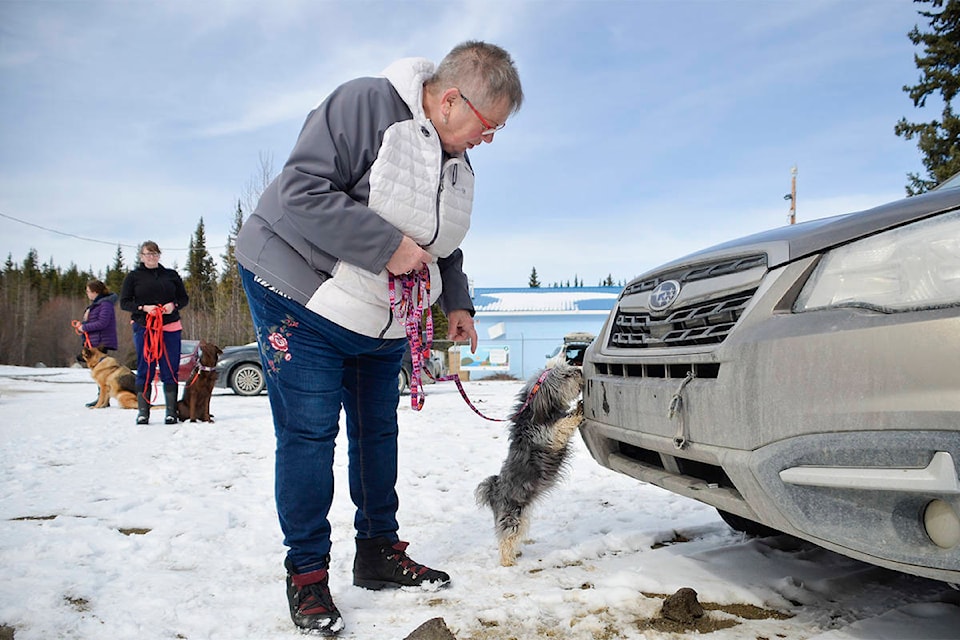The little grey dog sniffs the front bumper of the SUV, bouncing on its hind legs to reach the plastic. Pixie is so tiny that, standing on all-fours, the Subaru’s clearance is higher than she is tall, and so, she must stand on two, her front paws bracing her against the vehicle as her owner, standing just behind her, offers words of encouragement.
A few metres away sit a perky chocolate lab and handsome German shepherd, patiently waiting their turns to give the SUV a sniff and locate, exactly, where some birch essential oil was placed on the bumper earlier. The two are more likely what come to mind when one pictures a scent-detection dog, but that’s the beauty of the dogsport of nosework: it doesn’t discriminate, and only requires something most, if not all pups are born with anyway — a working snout.
Originally created by drug-and-bomb-detection dog-squads, nosework has gradually grown in popularity amongst the civilian crowd, with narcotics and explosives swapped out for more easily-obtainable (and legal) essential oils.
Basically, dogs search an area with their noses, sniffing around until they find the source of a smell. They then “alert” their handlers when they’ve found the source, and are rewarded with treats for correct finds.
Nosework has found its devotees in the Yukon too, Whitehorse Woofers Club secretary Michelle Wieser said in an interview April 5, with about 20 club members who have been doing nosework for about three years now.
“The club itself has always kind of been very focused around sort of competitive dog sports, like obedience and agility, but nosework has become really, really popular in the States and in bigger cities in Canada,” said Wieser, who runs her own dog-training business as well as nosework classes for the Woofers.
Wieser was first introduced to the sport about four years ago, when she started taking online nosework courses with her dog, who she said “had a lot of behaviour problems and a lot of fear issues” and wasn’t suited for agility or obedience work.
“I took a couple of online courses and absolutely fell in love with it and then started running classes for the Woofers Club… There was a small group of us to begin with, but it just kept building and building and building and now our classes for nosework, our beginner classes, seem to fill up really quickly,” she said.
Wieser attributes part of nosework’s growing popularity to the fact that it’s a low-barrier activity that allows “non-typical dogsport dogs” to participate.
“We’ve had bulldogs who were really good at it. Everyone always things that bulldogs can’t do much or aren’t good for obedience work — they love nosework,” she said.
“We even have had quite a few of the retired agility dogs who, you know, they’re a little too old to be jumping and we’ve had dogs that were blind do nosework, we’ve had dogs up to age 15 that are still coming to nosework practice and having a great time. So it’s really cool because it’s very inclusive and pretty much any dog can do nosework, and, you know, they absolutely love it.”
There’s been so much local interest and participation, in fact, that the Whitehorse Woofers will be hosting its first-ever United Kennel Club-sanctioned nosework trial next month. Dogs and their owners will first have to pass a pre-trial test before participating in outdoor, indoor, container and vehicle searches.
Each dog-and-handler team will have five minutes to locate the source of a smell; the handlers won’t know where the source is hidden, and will have to trust their pups to find it.
The Whitehorse Woofers have been holding informal practices leading up to the trial. The News attended one held near the Yukon College’s Whitehorse campus.
About a half-dozen dogs of all shapes and sizes spent more than an hour sniffing their ways through a series of stations — a row of plastic containers, with only one containing a birch-scented item; a collection of toys and shoes scattered in a circle, with only one shoe having been scented; two vehicles with scented bumpers — and practice their alert signals.
Most of the dogs sat or laid down when they found the scent-source and stared up at their owners, or pawed at the source; Pixie, the tiny grey dog, would stand on her hind legs, or, in the case of the containers, would stand on the container she alerted on.
Other than the occasional squirrel-triggered moments of distractions, the dogs, and their enthusiastic owners, seemed totally immersed in the experience.
“It’s not the most exciting dog sport to watch,” practice organizer Carol Foster told the News, “but the dogs love it, and the owners too.”
The nosework pre-trial test and trials are scheduled to take place in Whitehorse from May 10 to 12. More information is available at facebook.com/events/378013359441332/
Contact Jackie Hong at jackie.hong@yukon-news.com
